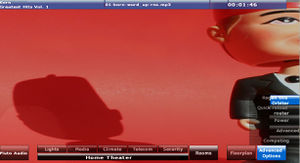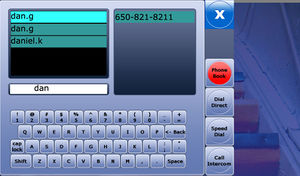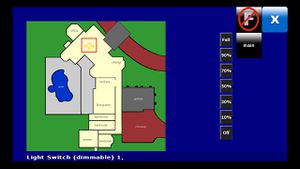Main Page
| This page was written by Pluto and imported with their permission when LinuxMCE branched off in February, 2007. In general any information should apply to LinuxMCE. However, this page should be edited to reflect changes to LinuxMCE and remove old references to Pluto. |
Pluto Home is the only solution seamlessly combining:
- media & entertainment with a server for music, movies and tv shows, plus a PVR and DVD Player,
- a home automation system to control everything in the home with touch-screen tablet and Bluetooth mobile phone controllers,
- a phone system with video conferencing,
- a security system that feeds you live video on your mobile phone when something happens, and lets you speak to visitors through your stereos, and
- a home PC solution.
A typical Pluto system consists of a Core: one PC acting as a dedicated server and interface to all the sub-components. The Core includes our own plug-and-play back-end so it listens for and auto configures all sorts of devices like network audio players (such as Squeeze Box), IP phones and cameras. The Core automatically exposes a network boot for any other PC's or thin clients you want to use as Media Directors, which you hook up to your TV/Stereo's to use as set top boxes, complete with a media player, PVR, video conferencing, intercom, and a GUI to control everything in the home. All Media Directors work together seamlessly as a total whole-house solution.
In addition to the usual infrared remote controls, Pluto includes remote control software that runs on Symbian Bluetooth mobile phones as well as Linux, Windows and Windows CE devices like webpads and pda's. They all feature cover art, interactive maps and floorplans, and let you control any device in the house. The UI is skinnable and multi-language. The mobile phone has a 'follow-me' feature so your media and other settings follow you from room to room. It switches from Bluetooth to cellular gprs/wap when you leave the house — you're always in control.
Contents
News
August 8, 2006
Version 2.0.0.40 of Pluto Home was released, including a new PnP system, configuration wizard, improved telecom, improved orbiter, and an updated 2.6.16.20 kernel. See the change log for complete details.
Features
Pluto Home is an all-in-one solution for your home that seamlessly combines media & entertainment, home automation, security, telecommunications and computing. Browse the features page, along with What can I do with Pluto? to see the possibilites available from Pluto Home.
Screenshots
-
Download
The simplest and easiest way to get Pluto Home is from the commercial web site's download page. There you will find a burnable CD image, suitable for quickly installing a new Core system. Pluto Home is also available as Debian packages and source.
Getting Started
This section has moved to Getting Started.
Support
User's Manual
This section has moved to User's Manual.
Mailing List
Support beyond that contained in this wiki can be found via the official Pluto Home forums and through the available mailing lists.
Configuring Pluto Home
FAQ
- Development status for all modules
- What does an appliance solution like Pluto cost?
- Is Pluto an appliance or software solution?
- Why buy a licensed Pluto product? What's the difference?
- Do I need Pluto? Can I use the projects by themselves?
- How do I login to a Linux console?
- How are media files organized?
- I can't access my media files over the network
- Reset the password for the Pluto Admin site
- What if you don't have a driver for my home automation devic
- What scenarios are created automatically?
- I'm a Linux user already. Should I use Pluto's distribution
- Why doesn't Pluto support encrypted DVD's?
Troubleshooting
Development
Author's Information
Information regarding author information can be found on the author's portion of the commercial website.
Programmer's Guide
There is a great deal of documentation on the Pluto Home platform available in the Programmer's Guide. This guide provides an overview of the Pluto Home architecture,
Software Used by Pluto Home
Pluto Home is often called a platform for developing smart home modules constructed by a variety of open source projects. The integration of these open source projects, such as Xine, Mythtv, and Asterisk, can be found in the Pluto Home Software Documentation.
Documentation by Device Templates
Pluto Home is an open source project and uses open source software. More information regarding Pluto Home's relationship to open source can be found on the open source information page, the license information page, what to do if you're an open source develper, and Pluto Home's open source strategy.
Report Bugs
Bugs may be reported via the bug tracking system, Mantis.
Source
Pluto is a pretty big project. Not counting GSD devices, Pluto's own code is already well over a million lines in hundreds of modules, with over 1,000 pages of online documentation, and in addition Pluto also incorporates lots of other big open source projects like Asterisk, Xine, MythTV, Firefox, VideoLan, SlimServer, etc., all of which have special Pluto 'wrappers' to allow them to work together seamlessly as a total home solution. For the brave of heart, you can also download modules by hand, and see all the dependencies and compatibility for each module.
You can browse the web based repository viewer. Or you can you do an anonymous svn checkout as follows:
svn co http://svn.plutohome.com/pluto/trunk/modulename
You can checkout all the software with if you use http://svn.plutohome.com/pluto/trunk/ as the repository location for the module name, or go to the repository viewer to find the name of the SVN directory for the module you are interested in.
Here are short instructions if you want compile your module with svn sources : Building_from_source.
Versions
The current version of Pluto home is 2.0.0.40, as of August 8, 2006. You may find information about this version via the official/commercial change log page, this wiki's version of the change log, further insight into 2.0.0.40, and information regarding Pluto Home's version numbering and several version trees.
PlutoVIP
Short Howto on Wiki
This section has been moved to Short Howto on Wiki.


